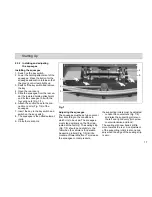
10
Safety Information
• Only refill distilled water.
• When the cells are in good condition,
never refill the battery acid.
• Spilled battery acid must never enter
the sewage system in its initial form,
it must be neutralized beforehand.
• Pay attention to legal requirements
and local directives.
• For further safety information, see
supplementary sheet 88-60-2554
"Notes on driving batteries".
1.5
Particular risks
• The following applies when locating
and clearing faults: Switch the vehi-
cle off, remove the key from the key
switch and disconnect the battery
plug!
• In the case of faults involving the
traction drive, stop the vehicle imme-
diately and remove the key from the
key switch!
1.5.1 Electronics
• Always disconnect the battery plug
before starting any work on the elec-
trical installations.
• Only use original fuses with the pre-
scribed amperage.
• In the case of defects in the electrical
installation, switch the vehicle off im-
mediately and clear the fault.
• Work on the electrical equipment
may only be carried out by electri-
cians who have received the neces-
sary training and in accordance with
the electrical engineering regula-
tions.
• The vehicle's electrical equipment
must be inspected/checked at regu-
lar intervals. Defects, such as loose
connections and cable damage,
must be rectified immediately.
1.5.2 Batteries
• Due to a change in the center of
gravity, only approved batteries may
be installed at the intended position.
• To prevent creeping currents, al-
ways keep the batteries clean and
dry and protect from contamination,
e.g. from metal dust.
• Never lay any metallic objects or
tools on batteries. Risk of short cir-
cuit and deflagration!
• Ensure sufficient ventilation in the
charging area when charging the
batteries. Otherwise there is a risk of
explosion!
• The seat console must be pivoted
open during the battery charging
process to prevent the development
of explosive oxyhydrogen!
• Only use the original charger! Pay
attention that the insulation is not ini-
tially damaged and not damaged
during the charging process. The ca-
ble must not rub against anything.
Do not use the charger if the insula-
tion is damaged.
• Ensure there are no naked flames
nearby when handling batteries, par-

































